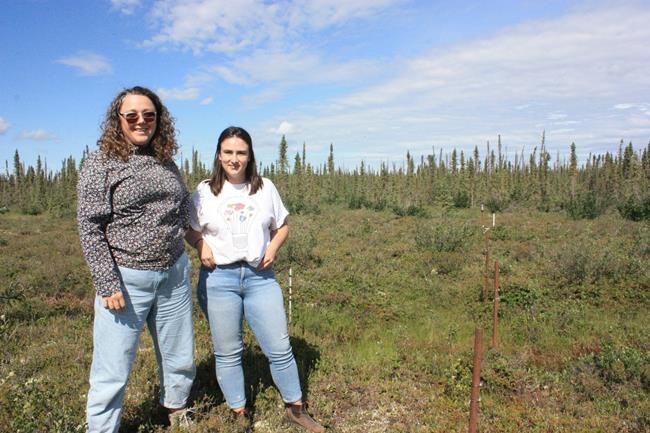
Erica Hille, acting director at the Western Arctic Research Centre, left, and Jennifer Humphries, permafrost specialist at the Aurora Research Institute, at a monitoring site in Inuvik, N.W.T., July 5, 2023. THE CANADIAN PRESS/Emily Blake
July 16, 2023 - 7:00 AM
INUVIK, N.W.T. - Off the side of the road not far from the airport in Inuvik, N.W.T., among the shrubs and spruce trees, a series of rusted metal bars are buried deep in the ground.
Installed in 2004, they are helping researchers measure how the ground is changing over time.
Jennifer Humphries, permafrost specialist at the Aurora Research Institute, says it's the only site in the world south of the treeline looking at the long-term thermal expansion and contraction of the ground connected to annual changes in air temperature. She says the ground there has been expanding two centimetres every year.
"It is a very neat site," she says.
Past clouds of buzzing insects, several trees nearby sport metal platforms attached to their slim trunks, measuring changes in tilt. As the permafrost degrades unevenly below, Humphries says it can cause what's known as "drunken forests" where off-kilter trees lean in different directions.
This is one of several places in the ice-rich Beaufort Delta where scientists are monitoring the permafrost and other environmental changes. As the Arctic warms faster than anywhere else in the world, they say permafrost degradation is having far-reaching effects.
"Up here, the permafrost is the foundation on which everything is built," Humphries says. "It affects the transportation of people, animals, water and the environment, development of vegetation. It affects and controls everything."
The Western Arctic Research Centre in Inuvik houses the Aurora Research Institute's headquarters and is home to the permafrost information hub. It supports several research projects, including permafrost monitoring along the Dempster and Inuvik-to-Tuktoyaktuk highways.
Erica Hille, acting director at the centre, says its work is collaborative and community-focused, and her team is working to make all of its data accessible. For example, she says the Inuvik Community Corporation requested they monitor ground temperatures and develop hazard maps at Caribou Hills near Reindeer Station, where the N.W.T. Geological Survey recorded 25 landslides in October 2009 and 80 in September 2017.
"Community members know what is happening, but why it is happening and what could it mean in the future is where I see us fitting," she says.
Studying permafrost can be complex and challenging, Humphries says. As a layer is buried underground, she says research methods capture snapshots in time and space. While researchers can make generalizations on baseline conditions for a region, every permafrost landscape is unique, she adds.
"I think that is often a distinction that makes it really tough for people to communicate problems," she says.
At the site near the airport, Humphries says it's a transition zone between tundra and forest with a decent snowpack. She says at-depth temperatures at the location are -0.9 C, likely warmer than people would expect.
"It tells us that the permafrost conditions in the Inuvik area are actually more susceptible to climate change than people had probably originally thought 20 years ago."
Driving through town, Humphries points out many homes are built on pilings rather than directly on the ground. That's because when the permafrost thaws and settles, it causes the foundation to move, which can require regular levelling.
Inuvik's landmark Our Lady of Victory Church, also known as the Igloo church for its iconic shape, has also been affected by permafrost thaw.
Originally opened in 1960, Humphries says the well designed building has vents that allow the basement and foundation to stay cold. During renovations several years ago, however, she says those vents were accidentally covered and the top was insulated, which caused permafrost degradation and settlement issues.
Those vents have since been reopened and Humphries says sensors installed in 2020 indicate settlement has stabilized.
There are a variety of solutions to address the effects of climate change on permafrost, including thermosyphons, tubes filled with carbon dioxide that can extract heat from the ground. Researchers at the Northwest Territories Geological Survey are also looking at whether compacting snow could help reduce temperatures and slow permafrost thaw.
Hille adds a Beaufort Sea coastal restoration project, focused on retrogressive thaw slumps along the coast of Kugmallit Bay, was completed last year. Researchers examined the potential of using indigenous plant species to revegetate the coastline and reduce ground temperatures, which she says yielded positive results.
"The limitation of a lot of engineering solutions is that they're only really good for smaller distinct areas," Humphries says, noting they can be expensive and labour intensive. "They're not as good for widespread application."
This report by The Canadian Press was first published July 16, 2023.
___
This story was produced with the financial assistance of the Meta and Canadian Press News Fellowship.
News from © The Canadian Press, 2023